break in TOYOTA RAV4 PHEV 2021 User Guide
[x] Cancel search | Manufacturer: TOYOTA, Model Year: 2021, Model line: RAV4 PHEV, Model: TOYOTA RAV4 PHEV 2021Pages: 666, PDF Size: 161.28 MB
Page 317 of 666
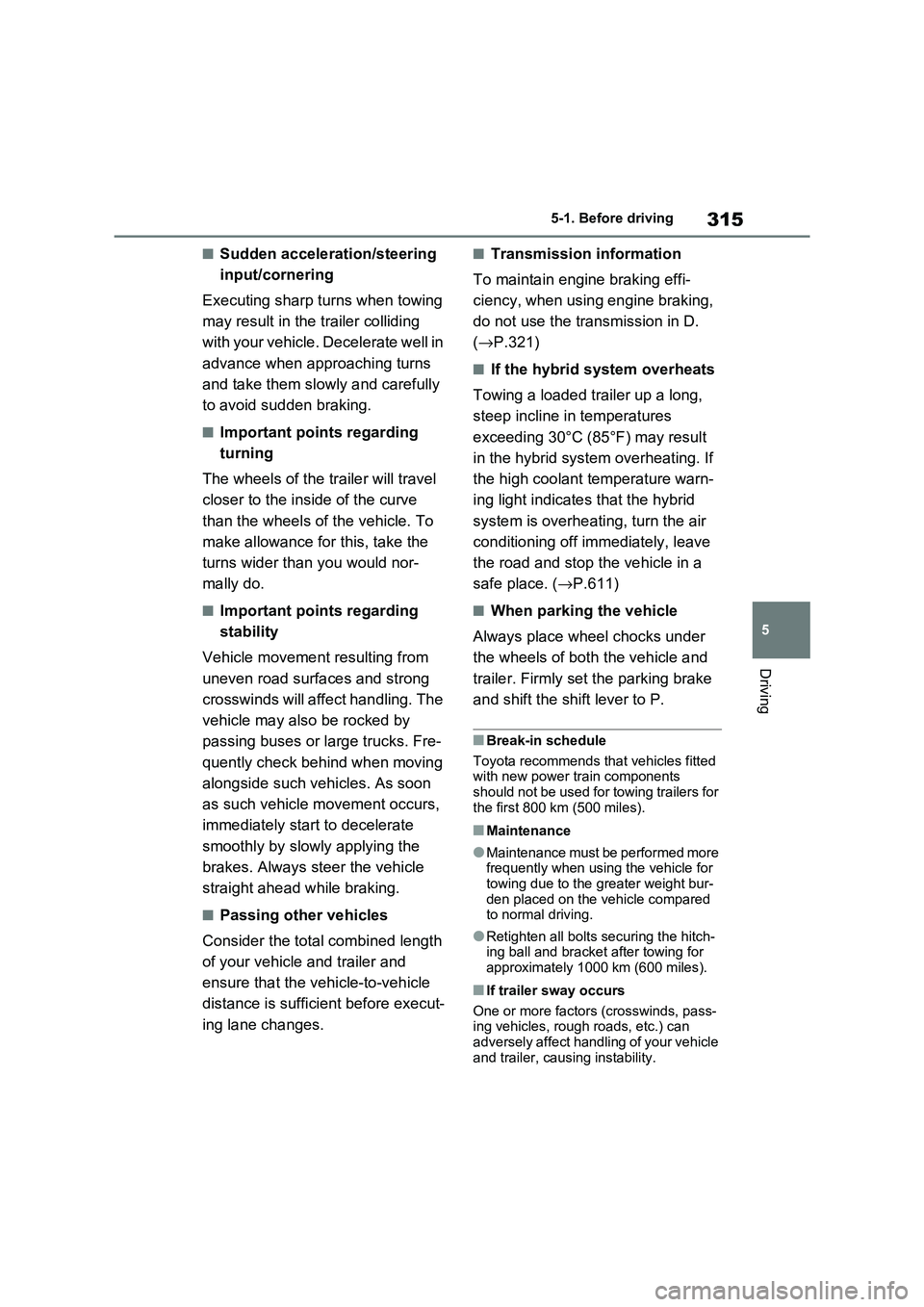
315
5
5-1. Before driving
Driving
■Sudden acceleration/steering
input/cornering
Executing sharp turns when towing
may result in the trailer colliding
with your vehicle. D ecelerate well in
advance when approaching turns
and take them slowly and carefully
to avoid sudden braking.
■Important points regarding
turning
The wheels of the tr ailer will travel
closer to the inside of the curve
than the wheels of the vehicle. To
make allowance for this, take the
turns wider than you would nor -
mally do.
■Important points regarding
stability
Vehicle movement resulting from
uneven road surfaces and strong
crosswinds will affect handling. The
vehicle may also be rocked by
passing buses or large trucks. Fre -
quently check behind when moving
alongside such vehicles. As soon
as such vehicle movement occurs,
immediately start to decelerate
smoothly by slowly applying the
brakes. Always steer the vehicle
straight ahead while braking.
■Passing other vehicles
Consider the total combined length
of your vehicle and trailer and
ensure that the vehicle-to-vehicle
distance is sufficient before execut -
ing lane changes.
■Transmission information
To maintain engine braking effi -
ciency, when using engine braking,
do not use the transmission in D.
( →P.321)
■If the hybrid system overheats
Towing a loaded trailer up a long,
steep incline in temperatures
exceeding 30°C (85°F) may result
in the hybrid system overheating. If
the high coolant temperature warn -
ing light indicates that the hybrid
system is overheating, turn the air
conditioning off immediately, leave
the road and stop the vehicle in a
safe place. ( →P.611)
■When parking the vehicle
Always place wheel chocks under
the wheels of both the vehicle and
trailer. Firmly set the parking brake
and shift the shift lever to P.
■Break-in schedule
Toyota recommends that vehicles fitted
with new power train components
should not be used for towing trailers for the first 800 km (500 miles).
■Maintenance
●Maintenance must be performed more frequently when using the vehicle for
towing due to the greater weight bur -
den placed on the vehicle compared to normal driving.
●Retighten all bolts securing the hitch - ing ball and bracket after towing for
approximately 1000 km (600 miles).
■If trailer sway occurs
One or more factor s (crosswinds, pass- ing vehicles, rough roads, etc.) can
adversely affect handling of your vehicle
and trailer, causing instability.
Page 365 of 666

363
5
5-5. Using the driving support systems
Driving
WARNING
■Before using LTA system
●Do not rely sole ly upon the LTA
system. The LTA system does not automatically drive the vehicle or
reduce the amount of attention that
must be paid to the area in front of the vehicle. The driver must always
assume full responsibility for driving
safely by paying careful attention to
the surrounding conditions and operating the stee ring wheel to cor-
rect the path of t he vehicle. Also,
the driver must take adequate breaks when fatigued, such as from
driving for a long period of time.
●Failure to perform appropriate driv -
ing operations and pay careful
attention may lead to an accident, resulting in death or serious injury.
●When not u sing the LTA system, use the LTA switch to turn the sys -
tem off.
■Situations unsuitable for LTA
system
In the following situations, use the LTA switch to tu rn the system off.
Failure to do so may lead to an acci -
dent, resulting in death or serious injury.
●Vehicle is driven on a road surface which is slippery due to rainy
weather, fallen snow, freezing, etc.
●Vehicle is driven on a snow-cov -
ered road.
●White (yellow) lines are difficult to
see due to rain, snow, fog, dust,
etc.
●Vehicle is driven in a temporary
lane or restricted lane due to con - struction work.
●Vehicle is driven in a construction zone.
●A spare tire, tire chains, etc. are equipped.
●When the tires have been exces - sively worn, or when the tire infla -
tion pressure is low.
●When tires of a size other than
specified are installed.
●Vehicle is driven in traffic lanes
other than that highways and free -
ways.
●When your vehicle is towing a
trailer or during emergency towing
■Preventing LTA system malfunc -
tions and operations performed by mistake
●Do not modify the headlights or
place stickers, etc. on the surface of the lights.
●Do not modify the suspension etc. If the suspension etc. needs to be
replaced, contact any authorized
Toyota retailer or Toyota authorized repairer, or any reliable repairer.
●Do not install or place anything on the hood or grille. Also, do not
install a grille guar d (bull bars, kan-
garoo bar, etc.).
●If your windshield needs repairs,
contact any autho rized Toyota retailer or Toyota authorized
repairer, or any reliable repairer.
■Conditions in which functions
may not operate properly
In the following situ ations, the func- tions may not operate properly and
the vehicle may depart from its lane.
Drive safely by always paying careful
attention to your surroundings and operate the steering wheel to correct
the path of the vehicle without relying
solely on the functions.
Page 451 of 666
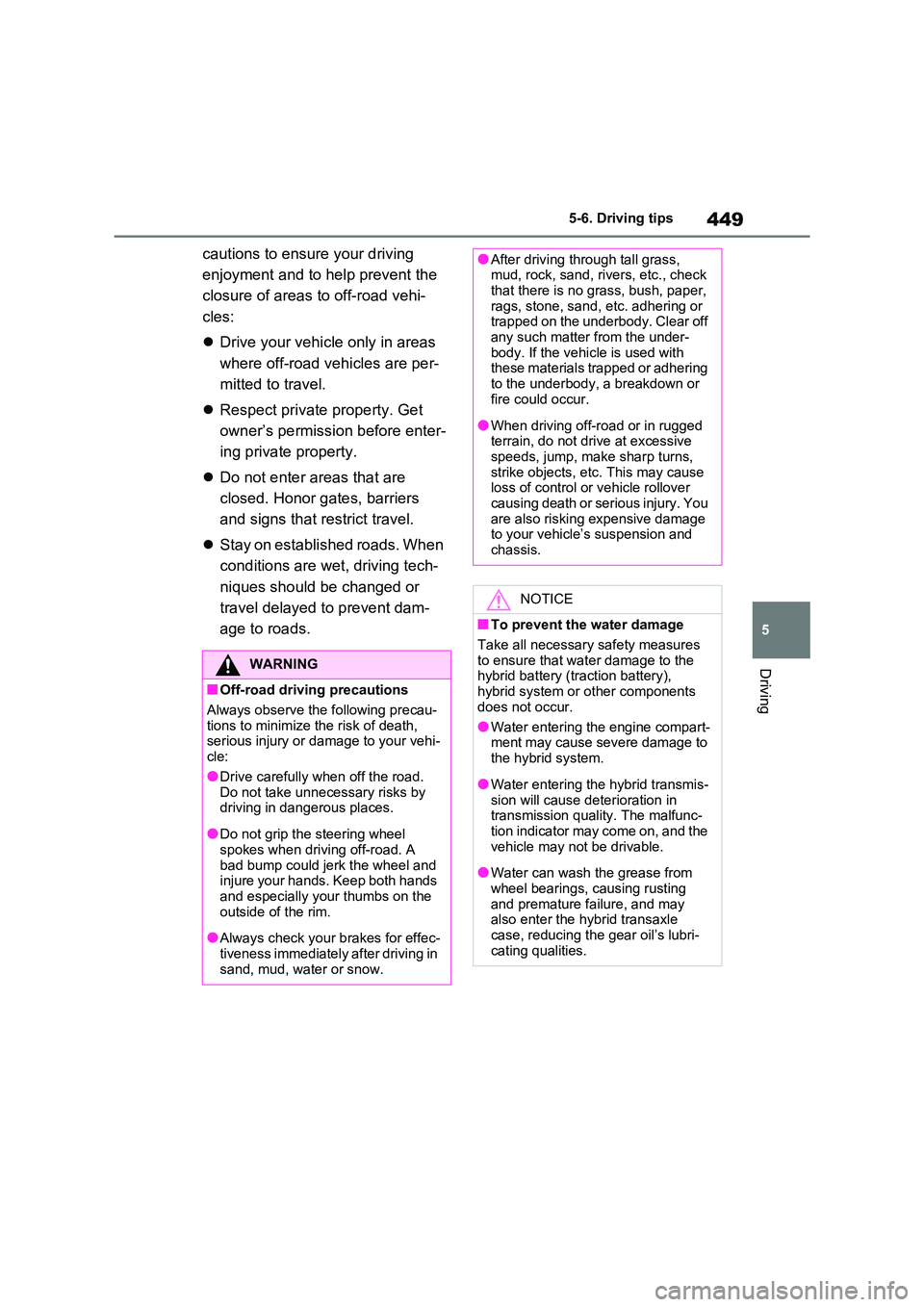
449
5
5-6. Driving tips
Driving
cautions to ensure your driving
enjoyment and to help prevent the
closure of areas to off-road vehi -
cles:
Drive your vehicle only in areas
where off-road vehicles are per -
mitted to travel.
Respect private property. Get
owner’s permission before enter -
ing private property.
Do not enter areas that are
closed. Honor gates, barriers
and signs that restrict travel.
Stay on established roads. When
conditions are wet, driving tech -
niques should be changed or
travel delayed to prevent dam -
age to roads.
WARNING
■Off-road drivin g precautions
Always observe the following precau -
tions to minimize the risk of death, serious injury or damage to your vehi -
cle:
●Drive carefully when off the road. Do not take unnecessary risks by
driving in dangerous places.
●Do not grip the steering wheel
spokes when driving off-road. A
bad bump could jerk the wheel and injure your hands. Keep both hands
and especially your thumbs on the
outside of the rim.
●Always check your b rakes for effec-
tiveness immediately after driving in sand, mud, water or snow.
●After driving through tall grass, mud, rock, sand, ri vers, etc., check
that there is no g rass, bush, paper,
rags, stone, sand, etc. adhering or trapped on the underbody. Clear off
any such matter from the under -
body. If the vehi cle is used with these materials trapped or adhering
to the underbody, a breakdown or
fire could occur.
●When driving off-road or in rugged
terrain, do not drive at excessive speeds, jump, make sharp turns,
strike objects, etc. This may cause
loss of control or vehicle rollover causing death or serious injury. You
are also risking expensive damage
to your vehicle’s suspension and chassis.
NOTICE
■To prevent the water damage
Take all necessary safety measures
to ensure that wat er damage to the hybrid battery (tr action battery),
hybrid system or other components
does not occur.
●Water entering the engine compart -
ment may cause severe damage to
the hybrid system.
●Water entering the hybrid transmis -
sion will cause deterioration in transmission quality. The malfunc -
tion indicator may come on, and the
vehicle may no t be drivable.
●Water can wash the grease from
wheel bearings, causing rusting and premature fa ilure, and may
also enter the h ybrid transaxle
case, reducing the gear oil’s lubri - cating qualities.
Page 473 of 666
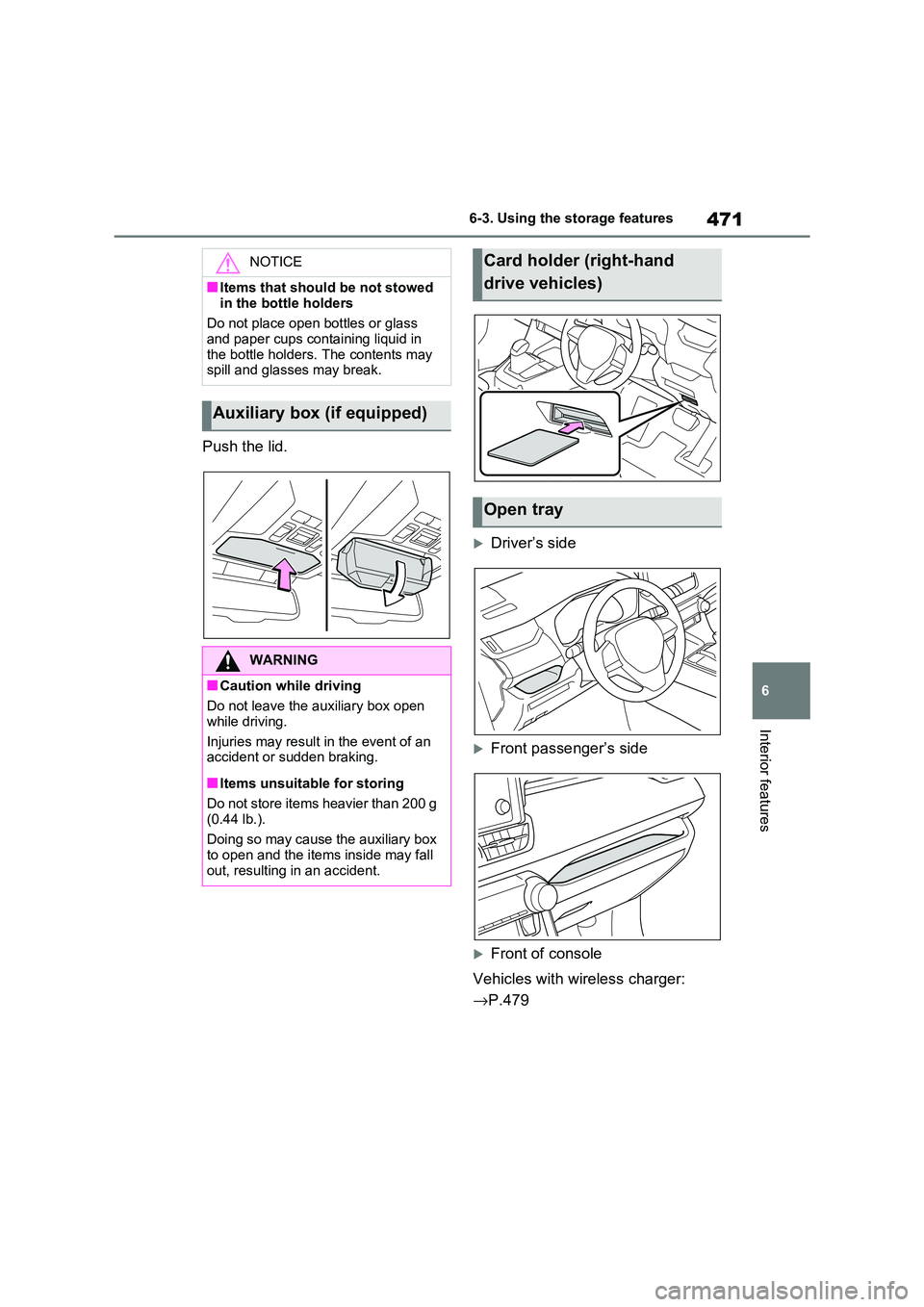
471
6
6-3. Using the storage features
Interior features
Push the lid.
Driver’s side
Front passenger’s side
Front of console
Vehicles with wireless charger:
→ P.479
NOTICE
■Items that should be not stowed
in the bottle holders
Do not place open bottles or glass and paper cups containing liquid in
the bottle holders. The contents may
spill and glasses may break.
Auxiliary box (if equipped)
WARNING
■Caution while driving
Do not leave the auxiliary box open
while driving.
Injuries may result in the event of an accident or sudden braking.
■Items unsuitable for storing
Do not store items heavier than 200 g
(0.44 lb.).
Doing so may cause the auxiliary box
to open and the items inside may fall out, resulting in an accident.
Card holder (right-hand
drive vehicles)
Open tray
Page 486 of 666
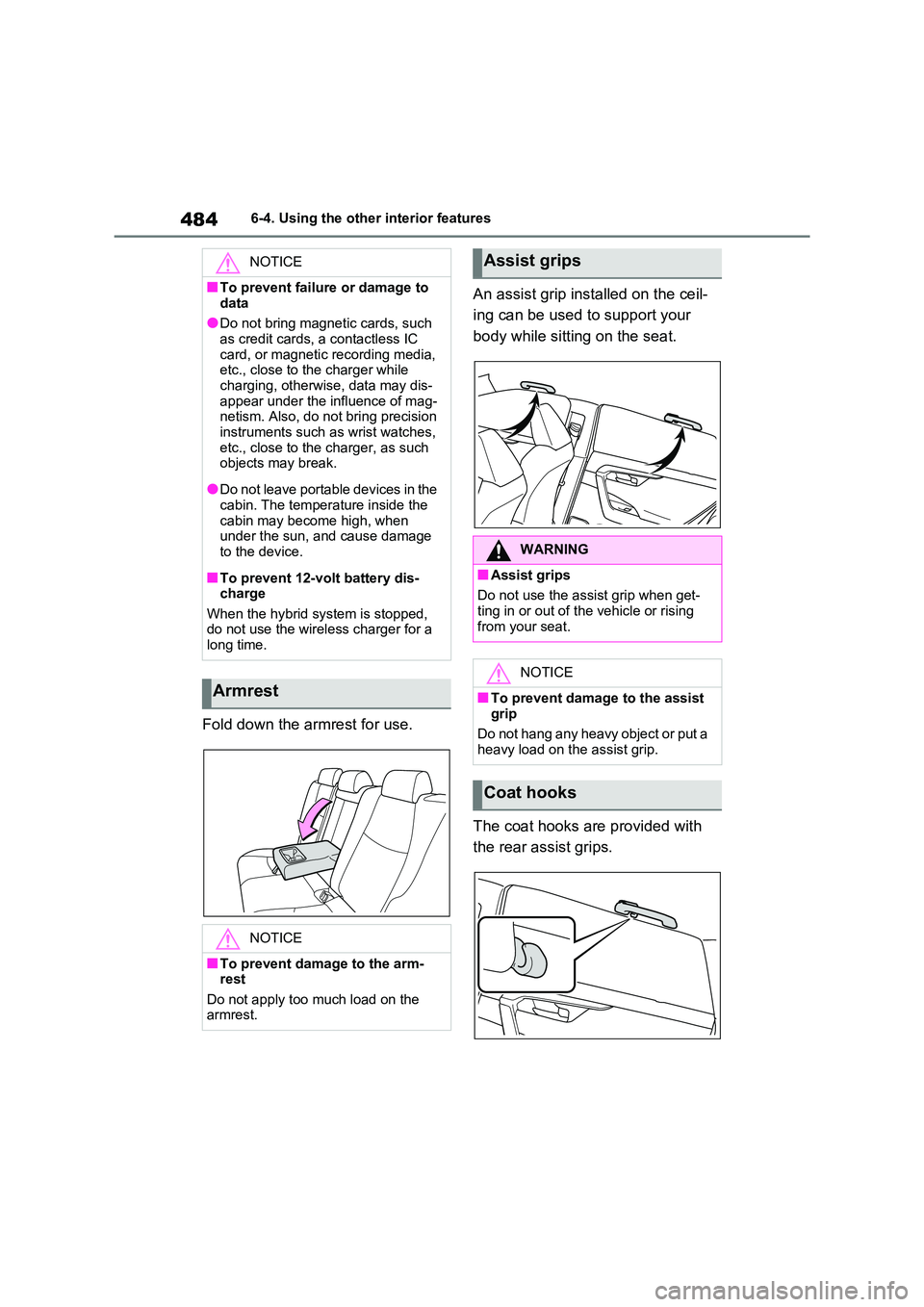
4846-4. Using the other interior features
Fold down the armrest for use.
An assist grip inst alled on the ceil-
ing can be used to support your
body while sitti ng on the seat.
The coat hooks are provided with
the rear assist grips.
NOTICE
■To prevent failure or damage to
data
●Do not bring magnet ic cards, such as credit cards, a contactless IC
card, or magnetic recording media,
etc., close to the charger while charging, otherwis e, data may dis-
appear under the influence of mag -
netism. Also, do not bring precision
instruments such as wrist watches, etc., close to the charger, as such
objects may break.
●Do not leave portable devices in the
cabin. The temperature inside the
cabin may become high, when under the sun, and cause damage
to the device.
■To prevent 12-volt battery dis -
charge
When the hybrid syst em is stopped, do not use the wireless charger for a
long time.
Armrest
NOTICE
■To prevent damage to the arm -
rest
Do not apply too much load on the armrest.
Assist grips
WARNING
■Assist grips
Do not use the a ssist grip when get-
ting in or out of t he vehicle or rising
from your seat.
NOTICE
■To prevent damage to the assist
grip
Do not hang any heavy object or put a
heavy load on th e assist grip.
Coat hooks
Page 533 of 666
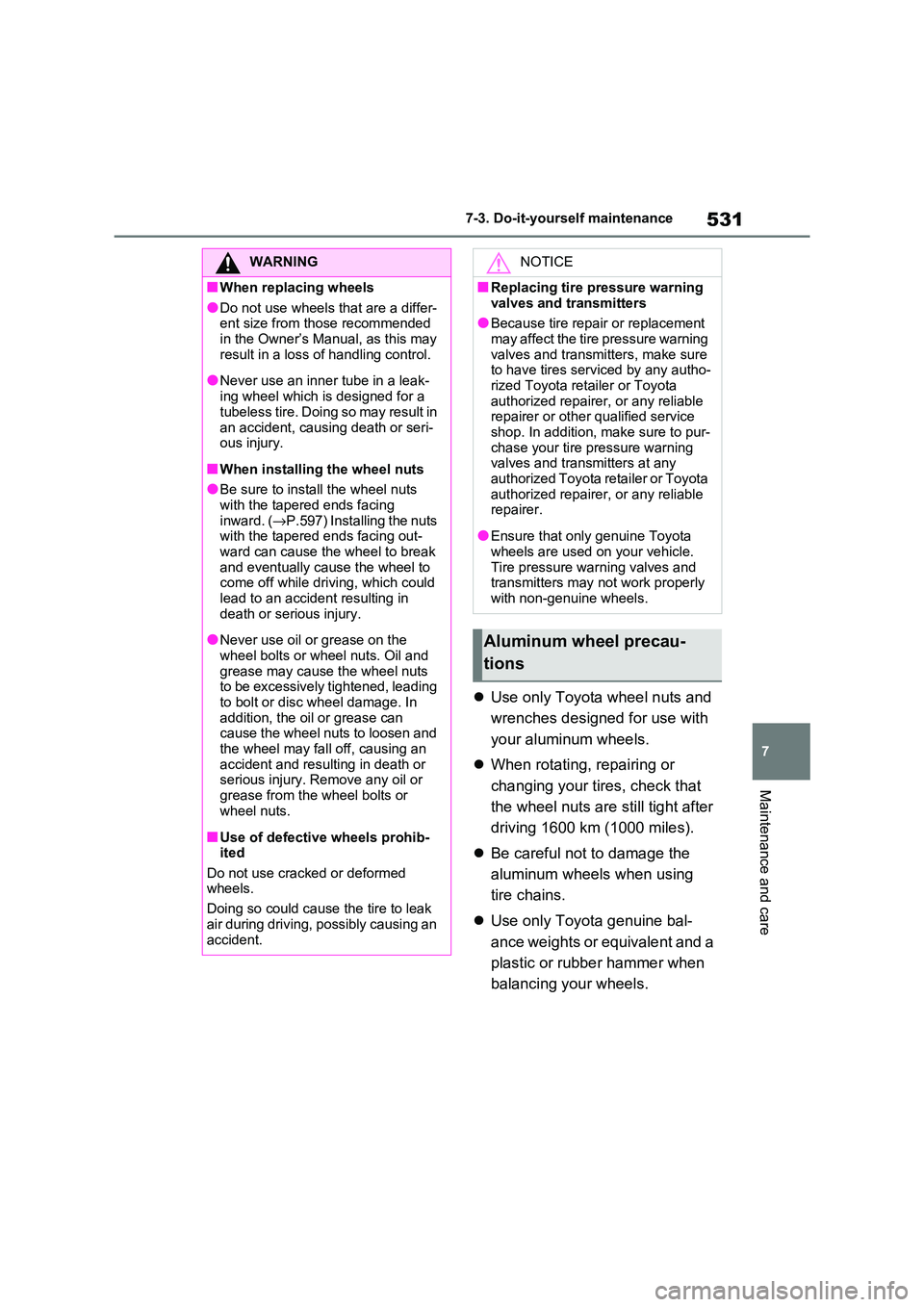
531
7
7-3. Do-it-yours elf maintenance
Maintenance and care
Use only Toyota wheel nuts and
wrenches designed for use with
your aluminum wheels.
When rotating, repairing or
changing your tires, check that
the wheel nuts are still tight after
driving 1600 km (1000 miles).
Be careful not to damage the
aluminum wheels when using
tire chains.
Use only Toyota genuine bal-
ance weights or equivalent and a
plastic or rubber hammer when
balancing your wheels.
WARNING
■When replacing wheels
●Do not use wheels that are a differ -
ent size from those recommended in the Owner’s Manual, as this may
result in a loss of handling control.
●Never use an inner tube in a leak -
ing wheel which is designed for a
tubeless tire. Doing so may result in
an accident, causing death or seri - ous injury.
■When installing the wheel nuts
●Be sure to install the wheel nuts
with the tapered ends facing
inward. ( →P.597) Installing the nuts with the tapered ends facing out -
ward can cause the wheel to break
and eventually cause the wheel to come off while driving, which could
lead to an accident resulting in
death or serious injury.
●Never use oil or grease on the
wheel bolts or wheel nuts. Oil and grease may cause the wheel nuts
to be excessively tightened, leading
to bolt or disc wheel damage. In addition, the oil or grease can
cause the wheel nuts to loosen and
the wheel may fall off, causing an accident and resulting in death or
serious injury. Remove any oil or
grease from the wheel bolts or wheel nuts.
■Use of defecti ve wheels prohib- ited
Do not use cracked or deformed
wheels.
Doing so could cause the tire to leak
air during driving, possibly causing an
accident.
NOTICE
■Replacing tire pressure warning
valves and transmitters
●Because tire repair or replacement may affect the tire pressure warning
valves and transmitters, make sure
to have tires serviced by any autho - rized Toyota retailer or Toyota
authorized repairer, or any reliable
repairer or other qualified service
shop. In addition, make sure to pur - chase your tire pressure warning
valves and transmitters at any
authorized Toyota retailer or Toyota authorized repairer, or any reliable
repairer.
●Ensure that only genuine Toyota
wheels are used on your vehicle.
Tire pressure war ning valves and transmitters may not work properly
with non-genuine wheels.
Aluminum wheel precau -
tions
Page 546 of 666

5447-3. Do-it-yourself maintenance
nal facing up.
4 When installing, reverse the
steps listed.
WARNING
■Battery precautions
Observe the following precautions.
Failure to do so may result in death or
serious injury.
●Do not swallow the battery. Doing
so may cause chemical burns.
●A coin battery or button battery is
used in the electronic key. If a bat -
tery is swallowed, it may cause severe chemical burns in as little as
2 hours and may result in death or
serious injury.
●Keep away new and removed bat -
teries from children.
●If the cover cannot be firmly closed,
stop using the electronic key and stow the key in t he place where
children cannot reach, and then
contact any auth orized Toyota retailer or Toyota authorized
repairer, or any reliable repairer as
soon as possible.
●If you accidentally swallow a battery
or put a battery into a part of your body, get emergency medical atten -
tion immediately.
■To prevent battery explosion or leakage of flammable liquid or
gas
●Replace the batt ery with a new bat- tery of the same type. If a wrong
type of battery i s used, it may
explode.
●Do not expose batteries to
extremely low pressure due to high altitude or extremely high tempera -
tures.
●Do not burn, break or cut a battery.
■Certification for the electronic key battery
CAUTION
RISK OF EXPLOSION IF BATTERY IS REPLACED BY AN INCORRECT
TYPE.
DISPOSE OF USED BATTERIES ACCORDING TO THE INSTRUC -
TIONS
NOTICE
■When replacing the battery
Use a flathead screwdriver of appro - priate size. Applying excessive force
may deform or damage the cover.
■For normal operation after
replacing the battery
Observe the following precautions to prevent accidents:
●Always work with dry hands.
Moisture may cause the battery to rust.
●Do not touch or move any other component inside the remote con -
trol.
●Do not bend either of the battery
terminals.
Page 549 of 666
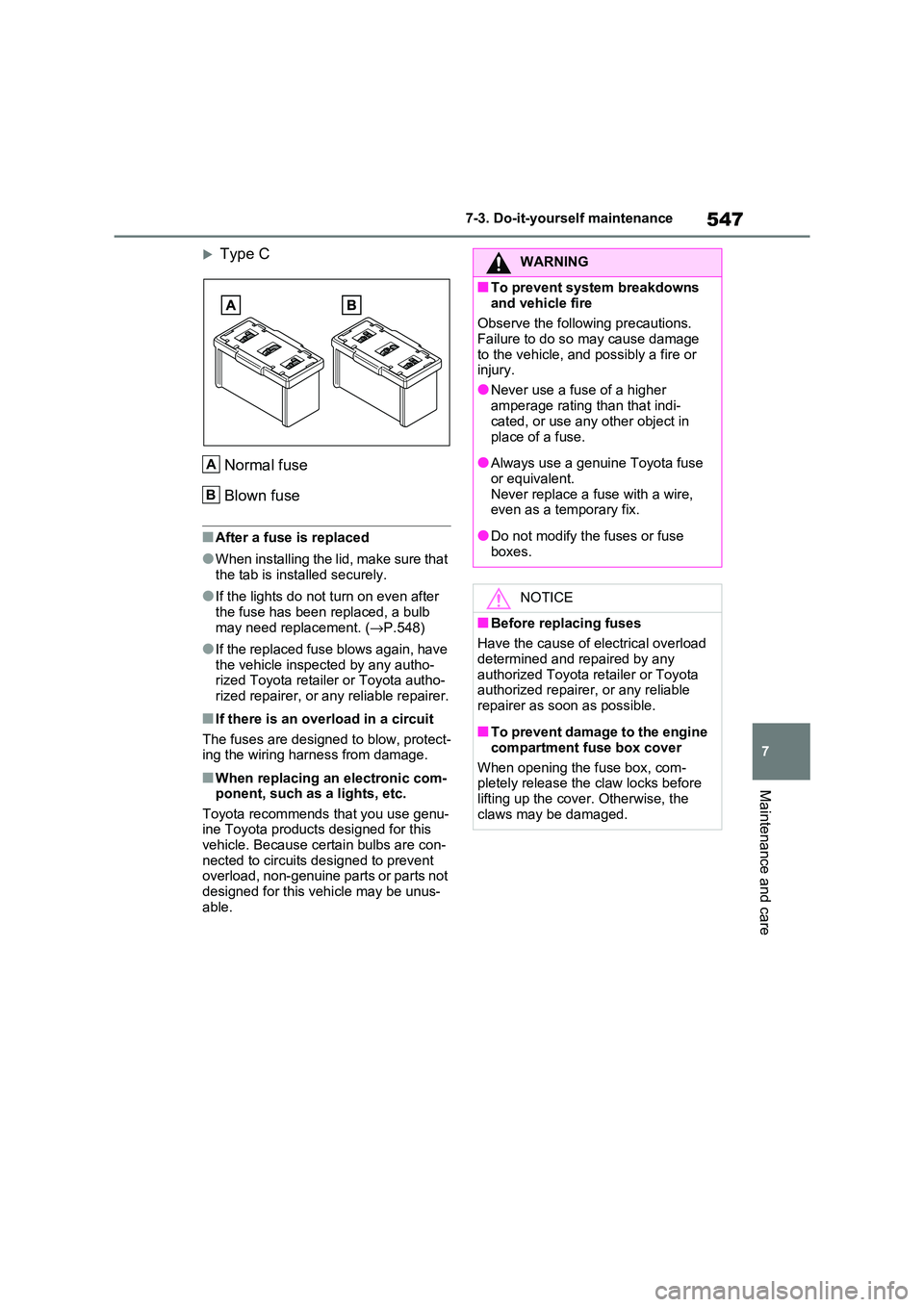
547
7
7-3. Do-it-yours elf maintenance
Maintenance and care
Type C
Normal fuse
Blown fuse
■After a fuse is replaced
●When installing the lid, make sure that
the tab is installed securely.
●If the lights do not t urn on even after
the fuse has been replaced, a bulb
may need replacement. ( →P.548)
●If the replaced fuse blows again, have
the vehicle inspec ted by any autho-
rized Toyota retailer or Toyota autho - rized repairer, or any reliable repairer.
■If there is an over load in a circuit
The fuses are designed to blow, protect -
ing the wiring har ness from damage.
■When replacing an electronic com- ponent, such as a lights, etc.
Toyota recommends that you use genu -
ine Toyota product s designed for this vehicle. Because certain bulbs are con -
nected to circuits de signed to prevent
overload, non-genuine parts or parts not designed for this vehicle may be unus -
able.
A
B
WARNING
■To prevent system breakdowns
and vehicle fire
Observe the following precautions. Failure to do so may cause damage
to the vehicle, and possibly a fire or
injury.
●Never use a fu se of a higher
amperage rating than that indi -
cated, or use any other object in
place of a fuse.
●Always use a genuine Toyota fuse
or equivalent. Never replace a fuse with a wire,
even as a temporary fix.
●Do not modify the fuses or fuse
boxes.
NOTICE
■Before replacing fuses
Have the cause of el ectrical overload
determined and repaired by any authorized Toyota retailer or Toyota
authorized repairer, or any reliable
repairer as soon as possible.
■To prevent damage to the engine
compartment fuse box cover
When opening the fuse box, com - pletely release th e claw locks before
lifting up the cover. Otherwise, the
claws may be damaged.
Page 562 of 666
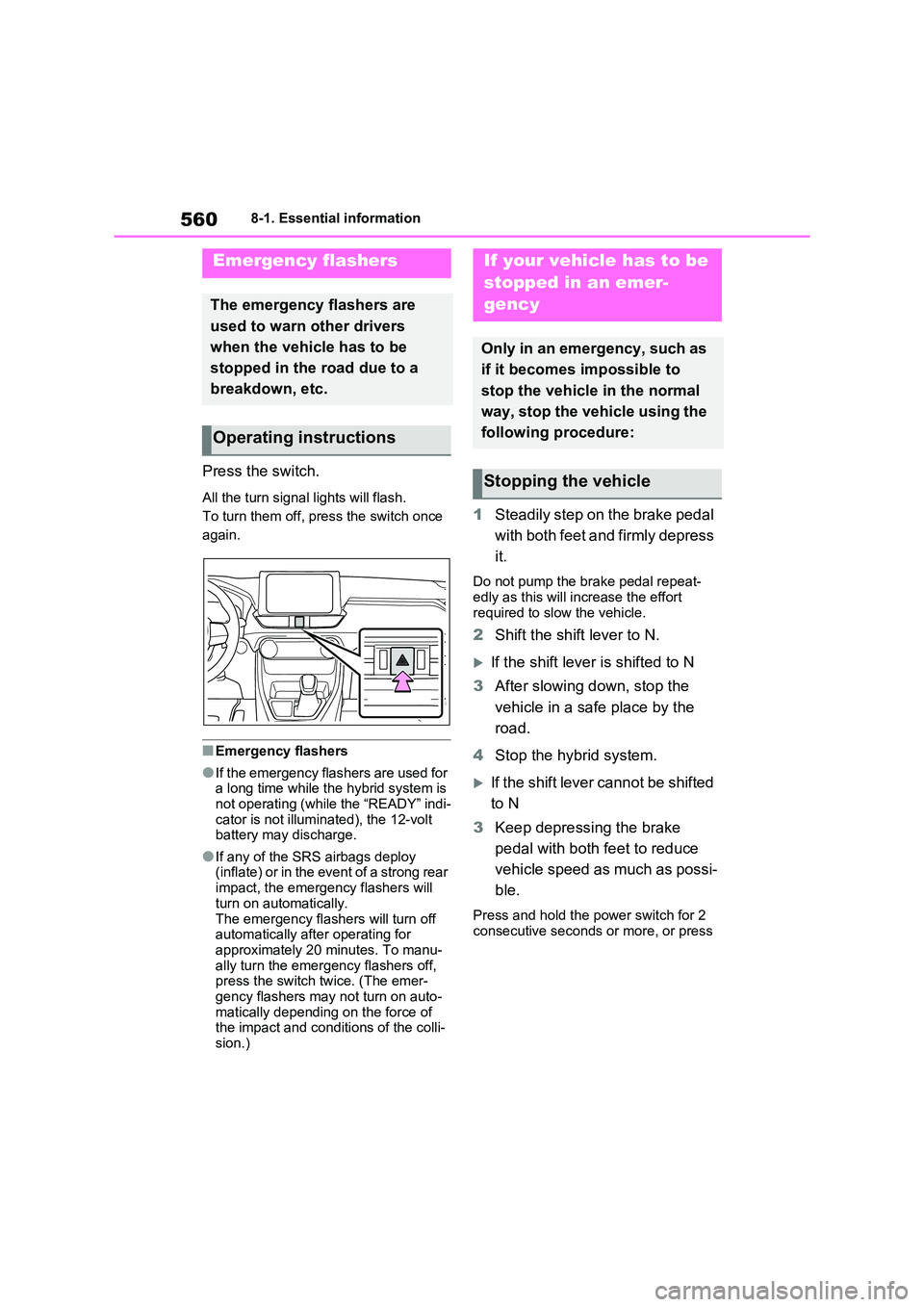
5608-1. Essential information
8-1.Essential information
Press the switch.
All the turn signal lights will flash.
To turn them off, press the switch once
again.
■Emergency flashers
●If the emergency flashers are used for a long time while the hybrid system is
not operating (while the “READY” indi -
cator is not illumi nated), the 12-volt battery may discharge.
●If any of the SRS airbags deploy (inflate) or in the event of a strong rear
impact, the emergency flashers will
turn on automatically.
The emergency flashers will turn off automatically after operating for
approximately 20 m inutes. To manu-
ally turn the emerg ency flashers off, press the switch twice. (The emer -
gency flashers may not turn on auto -
matically depending on the force of the impact and co nditions of the colli-
sion.)
1 Steadily step on the brake pedal
with both feet and firmly depress
it.
Do not pump the brake pedal repeat -
edly as this will in crease the effort required to slow the vehicle.
2 Shift the shift lever to N.
If the shift lever is shifted to N
3 After slowing down, stop the
vehicle in a saf e place by the
road.
4 Stop the hybrid system.
If th e s hif t le ver ca nn o t b e s hif te d
to N
3 Keep depressing the brake
pedal with both feet to reduce
vehicle speed as much as possi -
ble.
Press and hold the power switch for 2
consecutive seconds or more, or press
Emergency flashers
The emergency flashers are
used to warn other drivers
when the vehicle has to be
stopped in the road due to a
breakdown, etc.
Operating instructions
If your vehicle has to be
stopped in an emer-
gency
Only in an emergency, such as
if it becomes impossible to
stop the vehicle in the normal
way, stop the vehicle using the
following procedure:
Stopping the vehicle
Page 652 of 666

650Alphabetical Index
Blower customization ................. 454
Front seat concent rated airflow
mode (S-FLOW) ...................... 457
Humidity sensor ......................... 459
Remote Air Conditioning System460
Automatic headlight leveling system
..................................................... 333
Automatic High Beam (AHB) ....... 334
Automatic light control system ... 332
Auxiliary box ................................. 471
Average fuel consumption .......... 198
Average fuel economy ................. 181
Average vehicle speed ......... 185, 198
B
Back door ........ .............................. 210
Hands Free Power Back Door ... 215
Power back door ........ ................ 213
Wireless remote con trol ............. 213
Back-up lights
Replacing light bulbs .................. 548
Wattage...................................... 626
Battery (12-volt batte ry) ............... 506
If the 12-volt batt ery is discharged
................................................. 606
Preparing and c hecking before win-
ter ............................................ 445
Replacing ................................... 609
Warning light .............................. 569
Battery (tracti on battery)................ 94
Charging .................................... 135
Location ....................................... 94
Specification............................... 621
Blind Spot Monitor (BSM) ............ 393
Blind Spot Monitor function ........ 408
Rear Crossing Traff ic Alert function
................................................. 411
Bottle holders ............................... 470
Brake
Brake Hold ................................. 329
Parking brake ............................. 326
Regenerative braking ................... 90
Warning light ..............................568
Brake assist...................................438
Brake Hold .....................................329
Brake Override System ................301
Break-in tips .................................. 301
BSM (Blind Spot Monitor) ............393
Blind Spot Monitor function ........ 408
Rear Crossing Traffic Alert function
.................................................411
C
Card holder.................................... 471
Care
Aluminum wheels .......................488
Exterior ....................................... 488
Front camera ..............................345
Interior ........................................491
Radar sensor..............................345
Seat belts ...................................491
Water-repellent coating .............. 489
Cargo hooks .................................. 472
Chains ............................................447
Charging
“My Room Mode” .......................153
AC charging cable ...................... 108
Charging equipment ................... 105
Charging indicator ...................... 106
Charging messages ................... 160
Charging procedure ................... 135
Charging schedule function........ 144
Charging time may increase ...... 128
High voltage components............. 94
How to charge ............................ 135
Information related to charging dis -
play .......................................... 131
Opening and closing the charging
port lid ......................................106
Power sources precautions ........ 125
Power sources that can be used 124
Safety functions..........................132